Every year, scholarship and education providers draw upon insights and trends to refine their offerings to catalyse students’ career goals, championing their academic development and connecting them to affiliated industries and the plethora of opportunities that come with it.
As a thought leader in the scholarship services industry and curator of unbiased education-related content, Scholarship Guide is back with new student insights from its 2021 survey. The survey results reflect the sentiments of GCE A-Level and International Baccalaureate (IB) students, polytechnic students, and university undergraduates on topics regarding higher education, scholarships, and career prospects, also observing the potential shifts in mindsets amidst a dragging pandemic.
As Scholarship Guide continues to work in close partnership with providers to offer students strategic support in areas of need, it hopes the survey insights can inspire students and help them discover new perspectives and solutions in their higher education pursuits.
2021 Insights Summary
- Amidst the looming pandemic uncertainties, a local education preference remains.
- Singapore’s newer universities (SUTD, SIT, and SUSS) gain popularity, as more students want an industry-centric and practice-oriented education.
- Students’ course preferences reflect the growing focus on data, innovation, and human capital management in the nation’s future economy.
- Japan, Korea, China, and the Scandinavian countries have caught on as popular destinations for studying abroad.
- Students fall back on the practicalities of admission requirements and course fees when deciding on a higher education institution. In the same way, affordability and quality of education are top considerations when evaluating options for overseas education.
- Without scholarships, family financial support remains the preferred way to fund further education, although the trend shows signs of slowing. Some students expect future employers to sponsor training.
- Most students set out to explore scholarships as early as in their first year of JC, IB, or polytechnic.
- Interest in scholarships is up year-over-year. (2021: 94%; 2020: 86%)
- Lack of scholarship information resulting in misinformation may be the primary reason why some students are not motivated to pursue scholarships.
- Internship experiences play a crucial role in preparing students for scholarship applications.
- Students evaluate sponsoring organisations and their scholarships based on the career opportunities they offer.
- The bond period becomes less of a concern when students can pursue a career they are interested in and have confidence in the organisation’s ability to help them progress. However, students have also expressed their preference for a shorter bond period or no bond at all.
- While NUS, NTU, MOE, and A*STAR continue to reign the Top 20 Scholarship Providers charts for the second consecutive year, Smart Nation Scholarship, SIA, OCBC, and NIE have made significant gains in their popularity rankings.
- Scholarship Guide is proud to be voted one of the leading sources of scholarship information for students.
Further Education Intentions
Same as the year before, most students plan to pursue further education, with the majority of them preferring a local education. Year-over-year, the preference for local education has grown stronger, from 66% in 2020 to 83% in 2021.
Amidst the uncertainties around countries opening their borders to international students, including mobility restrictions, vaccine requirements, and a whole range of other pandemic-related concerns, students continue to be cautious and hesitant about studying abroad.

The Local Scene
National University of Singapore (NUS), Nanyang Technological University (NTU), and Singapore Management University (SMU) continue to be the top three university choices amongst those planning to further their studies locally, a consistent insight since 2020.
However, the share across all six local universities has spread out more evenly in 2021, with more students attributing higher preference rankings to Singapore University of Technology and Design (SUTD), Singapore Institute of Technology (SIT), and Singapore University of Social Sciences (SUSS) than the year before. Polytechnic students have also been found to favour these three newer universities more than GCE A-Level and IB students.
The industry-centric education that SUTD, SIT, and SUSS offer and their applied learning focus can be credited for their growing popularity. The newer universities differentiate themselves by offering specialised curricula targeting the growth sectors of the economy, and more students have come to recognise the benefits of an inclusive, experiential, and practice-oriented education.

Polytechnic graduates have always been much sought after by industries, and private education institutions, with their collaborations with world-renowned universities, offer students a global education. Their flexible course arrangements also make them great options for working adults seeking to upgrade their qualifications.
Student respondents ranked their top three polytechnic choices in the survey, with the first place going to Ngee Ann Polytechnic (NP), followed closely by Singapore Polytechnic (SP) and Nanyang Polytechnic (NYP). Meanwhile, the finalists of students’ top five private higher learning institutions in Singapore go to Singapore Institute of Management (SIM), Raffles College of Higher Education, James Cook University (JCU) Singapore, Kaplan Higher Education Academy, and ESSEC Business School in their respective order of ranking.
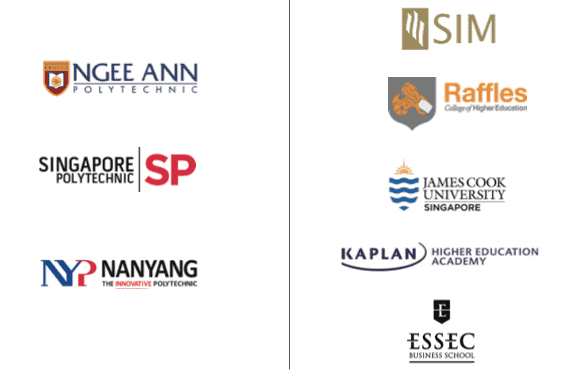
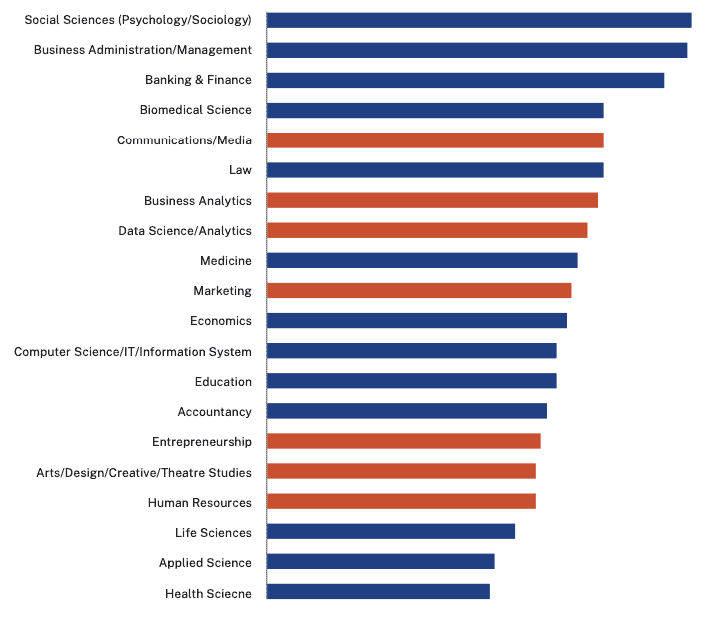
Top 50 Course Choices
The 2021 survey results reveal greater diversity in students’ preferred tertiary course of study, with 20 courses making up the top 50% of students’ choices in 2021 compared to only 14 in 2020.
Choices that remain top of the list year-over-year are Social Sciences, Business Administration, Banking & Finance, and Biomedical Science. However, both Medicine and Pharmacy slip in their popularity rankings. It is uncertain if the COVID-19 pandemic has impacted students’ perceptions of a medical or healthcare education and career.
New entrants making the top 50% list in 2021 include Communications / Media, Business Analytics, Data Science, Marketing, Entrepreneurship, Arts/ Design / Creative / Theatre Studies, and Human Resources. These course preferences reflect the growing focus on data, innovation, and human capital management in Singapore’s future economy.
Data Future: The data industry has seen rapid growth in Singapore. Accelerated by the pandemic and new technologies such as 5G, artificial intelligence, and the Internet of Things, it is no wonder expertise in data management and interpretation are in high demand.
Human Capital Future: The role of HR has changed dramatically in recent times. With globalisation and automation giving rise to digital workplaces and mobile workforces, combined with the constraint of Singapore’s rapidly ageing population, HR professionals play an essential role in supporting the nation’s economic transformation, helping people adapt to industry disruption. HR has also been impacting several key agendas of the responsible business mandate, such as diversity and inclusion (D&I). And in a post-pandemic world, the HR function is much needed to help ensure that businesses sustain while job losses are minimised.
Innovation Future: Recent events have instilled resilience, creativity, and a forward-thinking attitude in people and businesses. Whilst some were hard hit, others managed to defy the downturn. These success stories certainly motivate aspiring entrepreneurs.
Studying Abroad
The sentiments of local students are in line with global surveys, with the UK, US, Australia, and Canada securing their top places as favoured destinations for overseas education. However, there has been a year-over-year decline in the UK and US popularity in 2021. Destinations catching up are Japan, Korea, China, Sweden, and Finland.
The high quality of life standards, including safety and accessibility, make Japan an attractive destination for international students. Keen to attract more excellent students to study in Japan, the Japanese government has since launched a Global 30 Project initiative that aims to promote internationalisation at Japanese universities.
Quality education that comes with affordable tuition expenses and relatively pocket-friendly living costs are some of the reasons why South Korea is an increasingly popular choice. Besides its rich culture, kimchi, and not to mention K-pop, the country is especially notable for its expertise in IT and Robotics.
As for Sweden and Finland making the favourite list, there are many reasons to study in Scandinavia. These countries are usually ranked top 10 in the world for happiness and quality of life. They are also liberal countries where democracy, peace, and freedom of speech are highly valued. Scandinavians are the best non-native speakers of English in the world. Less degree-focused than other nationalities, the education systems in Sweden and Finland encourage students of all ages to study subjects they are interested in and can benefit them in their careers.
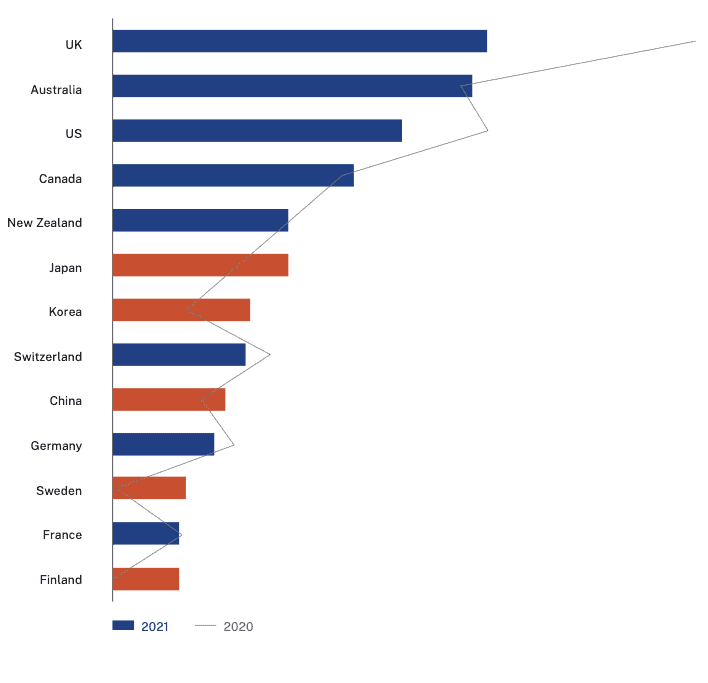
Japan, Korea, China, and the Scandinavian countries (Sweden & Finland) have caught on as popular destinations for studying abroad.
Influencing Factors
In navigating higher education choices, admission requirements, course fees, followed by the recognition of certificates, are the most influential factors that can sway a student’s decision between one institute and another. Course syllabus and the school’s facilitators and reputation are secondary considerations. School location and overseas attachment opportunities are not dominant deciding factors.
When evaluating overseas education options, the key considerations are affordability (23%) and the quality of education (21%). Prospects that come with the qualifications (16%) and the range of courses (16%) are ranked secondary, with the country’s culture (13%) and prestige (11%) being the least important.
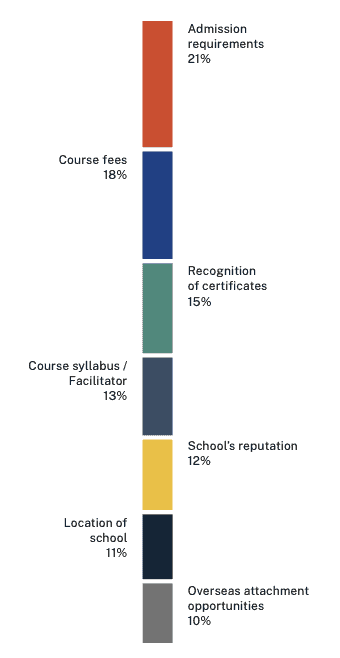
Money Talk
Surely a scholarship would have been a most welcome relief to help students balance their financial and academic commitments, but it is undoubtedly a competitive market. Offering a realistic view of how students plan to fund their further education without a scholarship, the 2021 survey results reveal that having financial support from family is the go-to option. Same as last year, students’ second and third most popular options are to work part-time or to use personal savings to fund their further studies.
When comparing year-over-year, students show signs of being less dependent on family financial support (2021: 21%; 2020: 26%). From almost out of nowhere, the option to utilise work-sponsored funding to pay for further studies has emerged (2021: 4%; 2020: 0.1%), indicating that students increasingly expect future employers to sponsor employees in their reskill and upskill training.
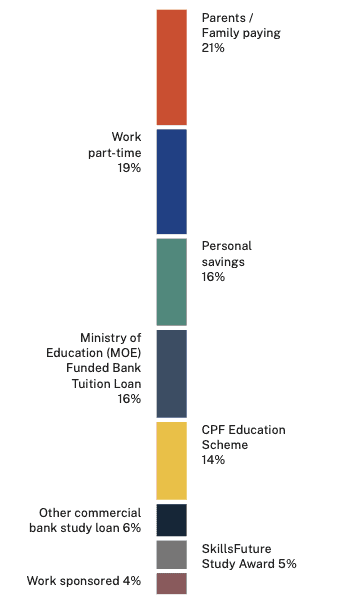
Without scholarships, family financial support remains the preferred way to fund further education, although the trend shows signs of slowing. Some students expect future employers to sponsor training.
Scholarship Interest
Over 50% of the student respondents have started to be interested in scholarships as early as in their first year of JC, IB, or polytechnic. Scholarship research undoubtedly takes time and effort, with 98% of the students acknowledging its importance.
Scholarship Guide recommends that students start their research as early as possible. Every scholarship has different rules and deadlines. Plan and start building a portfolio with the necessary credentials and experience. Not only be prepared to apply when the time comes, but also shine and outshine, securing the scholarship.

In 2021, 85% of student respondents intend to apply for scholarships; 9% of them already applied. These figures are higher than in 2020 (80% intend to apply; 6% applied). Meanwhile, interest in mid-term scholarships is slightly softer, with 76% of students intending to apply, and 4% of them already applied.
Applying for a scholarship can be a big decision, especially when it involves a bond. As such, some students may show keen interest but are hesitant or slow in putting their thoughts into action.
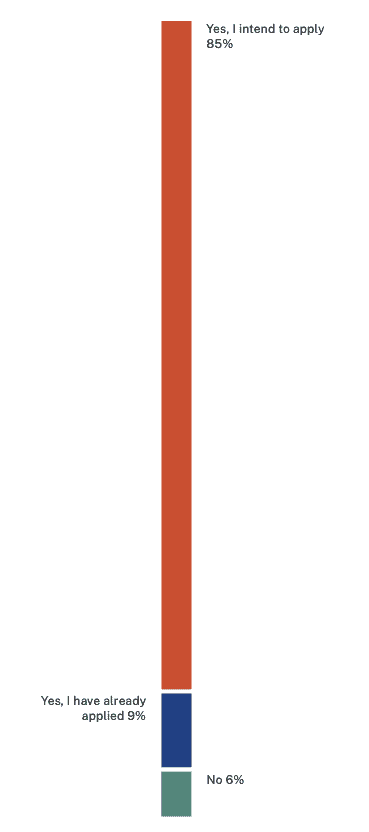
Students cite a lack of information as the primary reason for not being interested in scholarships. Survey results reveal that polytechnic students, more than their JC and IB peers, are more fearful of not keeping up with the required grades. University undergraduates, whilst they are more confident about maintaining their grades, feel more strongly about not wanting to be bonded.
Scholarships are awarded to students with all sorts of interests and talents. However, students often mistakenly believe that they are only available for those in the top brackets of academics or athletics, so they may tell themselves that they do not meet the scholarship requirements. But the truth is, students do not know where to start looking to find more information about scholarships, and as a result, have the wrong impression.
Scholarship providers must clearly communicate their scholarship offering and the wide range of eligibility criteria that exist. Listing all scholarships in one place, such as on the Scholarship Guide platform, shall make it accessible for students to find opportunities and look up their eligibility requirements.

Preparing to Apply for Scholarships
Students cite internshipsas one of the most important activities to help them prepare for scholarship applications, enabling them to explore career niches and develop their professional skills, and helping them validate their decision to apply with the sponsoring organisation. Providers must structure a successful internship program offering students meaningful work and ensure that these opportunities are readily available to all.
Besides researching the organisations to prepare themselves for scholarship applications, students feel that they can benefit by attending fairs and talks and reading scholarship-related articles.
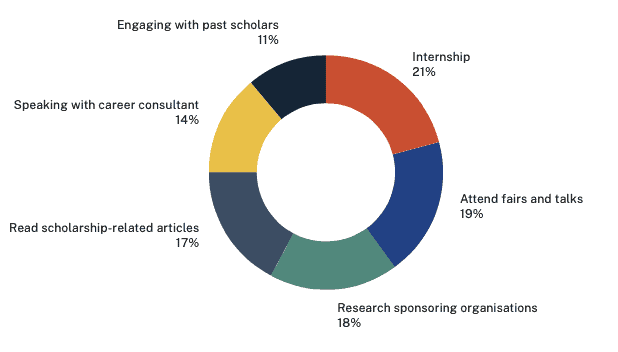
Evaluating Scholarships
Students prioritise career opportunities with the scholarship provider and the course of study when choosing a scholarship. The bond period and the value of the award are secondary considerations. Students are less concerned about the destination of study and the prestige that comes with it.
The course of study is a clear priority, as most scholarships have requirements as to which universities and programmes a scholar can apply. However, the insight around career opportunities demonstrates the forward-thinking attitude of students today as they look to their own future and hope to see alignment with the sponsoring organisation’s vision. Stories about the professional development journey of existing scholars would most likely interest them. It may also mean that students have less of an issue with the bond period of a scholarship if they are excited about the career path they are going to commit to.
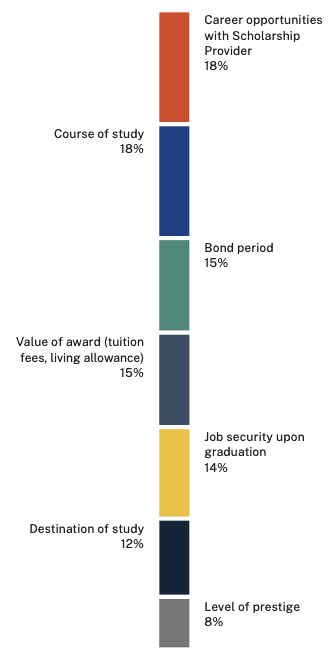
The scholarship market is a competitive one, not just for the candidates but also for scholarship providers. Students reveal that if they have to choose from various scholarship offers, they will evaluate the sponsoring organisations based on their ability to offer a career that best aligns with their interests, the practicalities of the award value, and potentially pick the one who can promise the best job mobility (exposure to various portfolios and career advancement).
The length of the bond criteria sits in the last place. As such, this finding reiterates the above insight around how the bond period becomes the least of a concern when students can pursue a career they are interested in and have confidence in the organisation’s ability to help them progress.
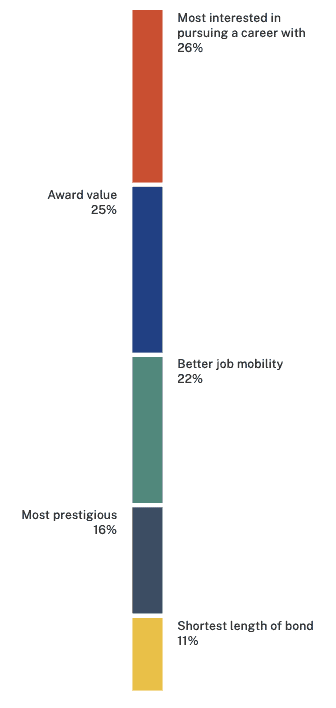
Top 20 Scholarship Providers
Students have been asked to select their top 10 scholarship providers. NUS, NTU, MOE, and A*STAR continue to be the hot favourites, reigning the charts for the second consecutive year in the same top four podium positions.
However, beyond the top four, rankings# have been volatile year-over-year. SMU moves into 5th place (up from 8th), and DSTA grabs the 8th spot (up from 13th). The Smart Nation Scholarship, offered by CSA, GovTech, and IMDA, moves up 20 whopping ranks into the 10th position. SIA, NIE, and OCBC soar up the 2021 charts, while PSC, HPB, and Raffles Medical take a dip in popularity rankings.
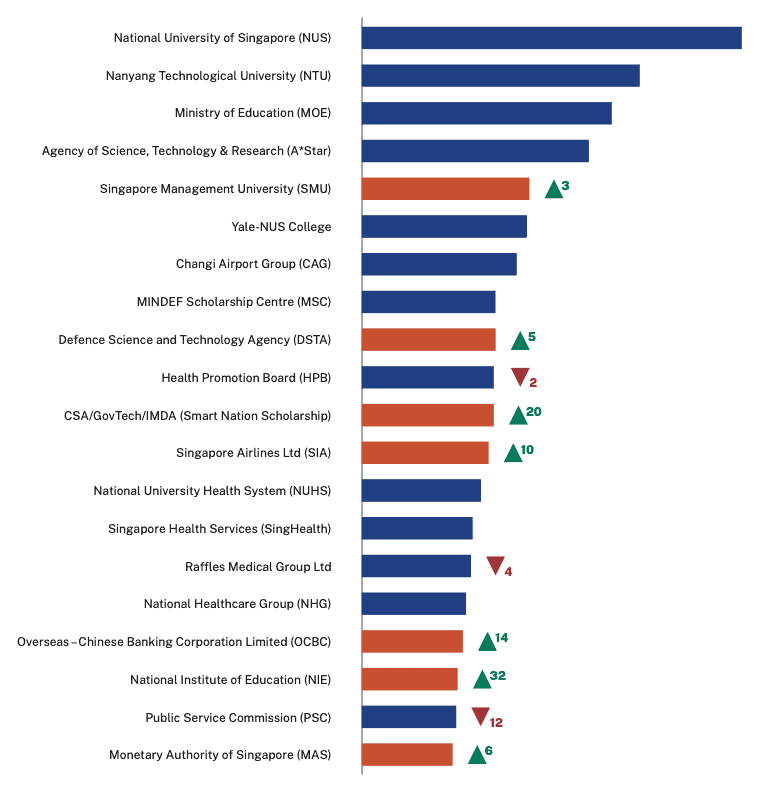
# Rankings are based on respondent feedback and do not represent Scholarship Guide’s views or endorsement.
Preferred Bond Duration
Survey results reveal a significant shift in attitude towards bond duration year-over-year. Unlike in 2020, where a 3- or 4-year bond period is acceptable for at least a full local scholarship, students have voted for less.
Students have made their point. The preferred length of a scholarship bond is 0, 1, or 2 years; no more. A 3- or 4- year bond period for a full overseas scholarship is borderline acceptable. The bond-free preference is in trend, and it is dominant across all types of scholarships, both full and partial, local and overseas.
As such, should scholarship providers restructure their offerings, especially the bond requirement, or work on refashioning their communications, clearly depicting a clear career path for their scholars that promises exposure and advancement?
*Scholarship Guide maintains a guide listing all bond-free scholarships for undergraduate studies in Singapore.
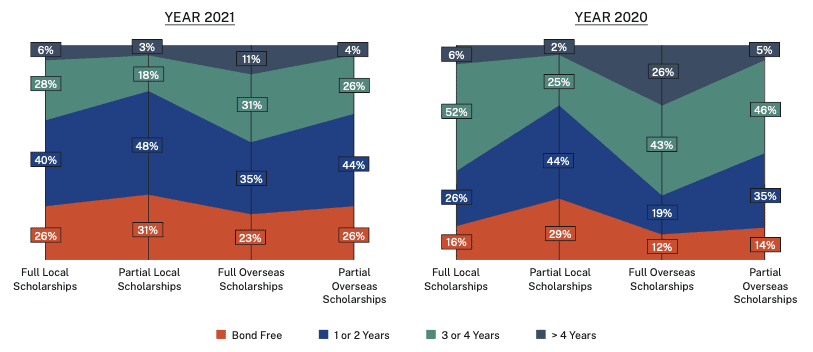
Other Scholarship Insights
Students acknowledge that scholarship providers seek versatility in their applicants. Besides exam grades, scholarship providers will evaluate the candidate’s leadership skills, communication skills, personality, CCA achievements, and other areas of involvement such as voluntary work.
Most students search for scholarships by doing a keyword search of the scholarship name. They would otherwise go directly to a familiar scholarship website or search for the scholarship provider, and most of the time (85%), they would find what they are looking for.
Scholarship Guide is proud to be voted one of the leading sources of scholarship information for students, ranked alongside their trusted school, teachers, and career counsellors.
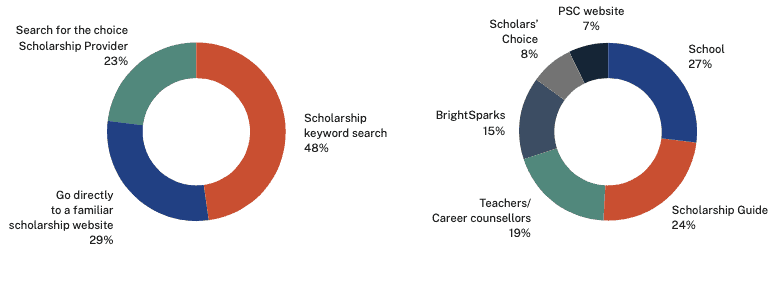
Nothing beats human interaction and word-of-mouth as students rank their teachers, counsellors, family, peers, mentors, and the people they engage with at career fairs and talks at the top of the list as the most influential in impacting their scholarship choice.
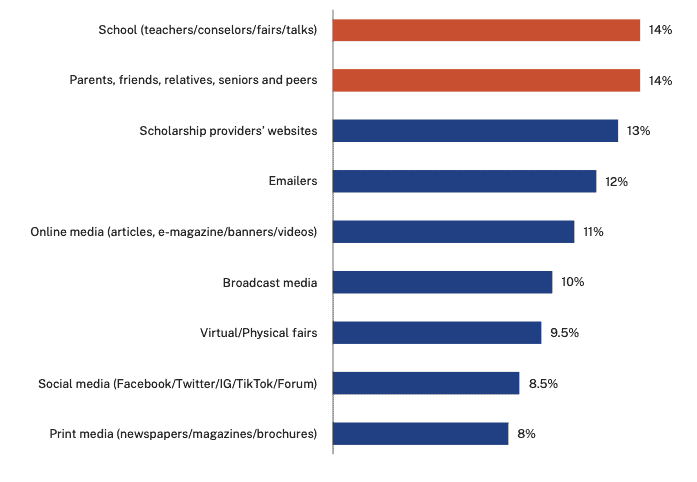
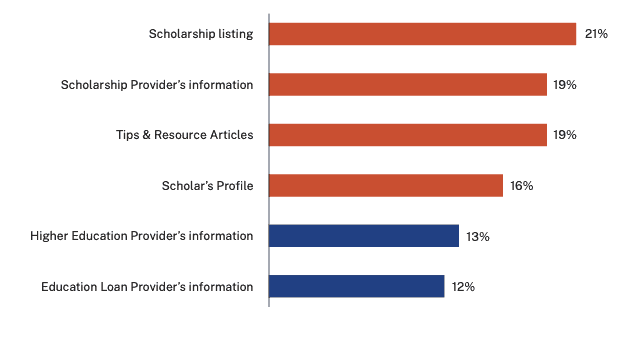
Students have voted to see more listings, provider’s information, tips and resources articles, and scholar’s profiles on scholarship websites.

